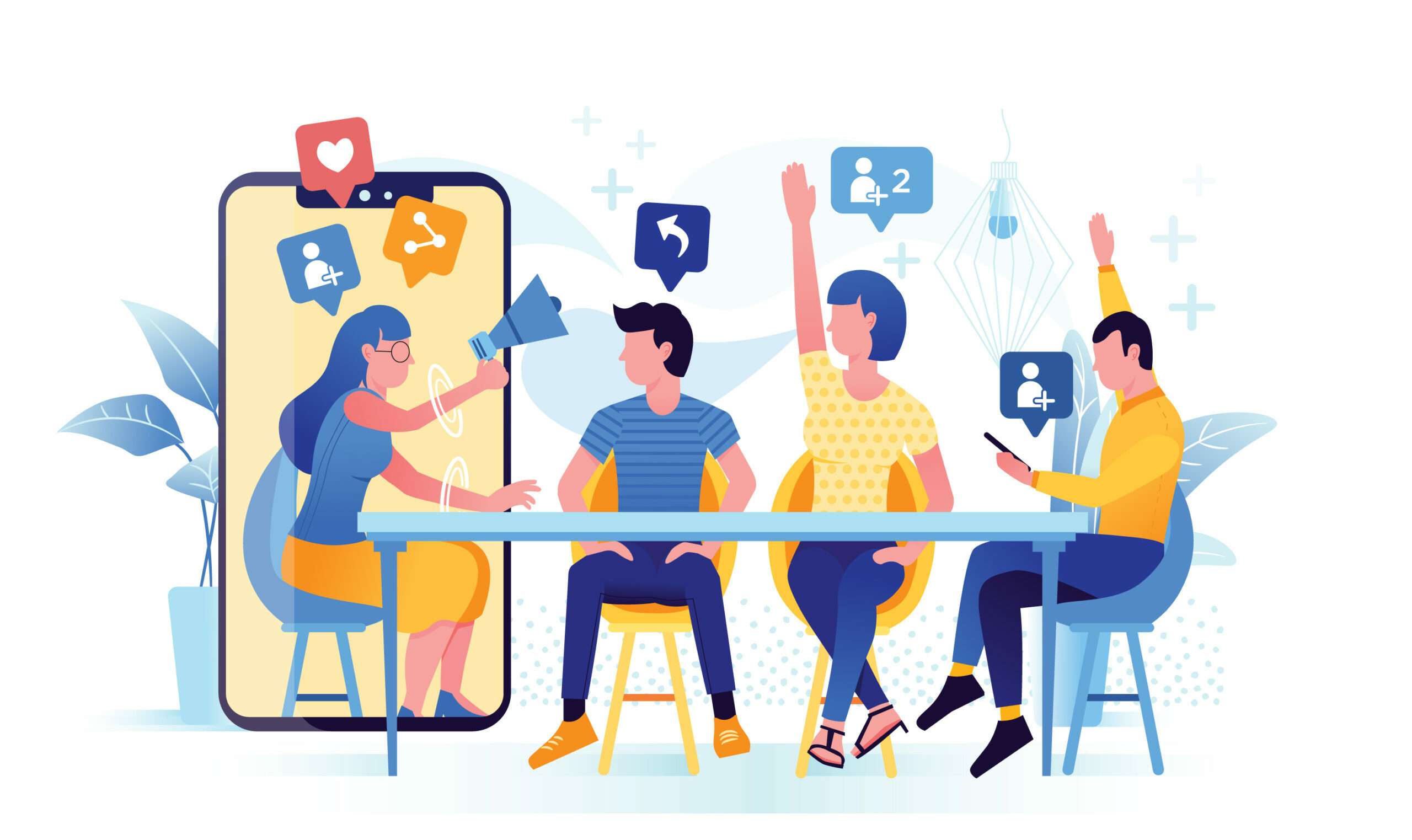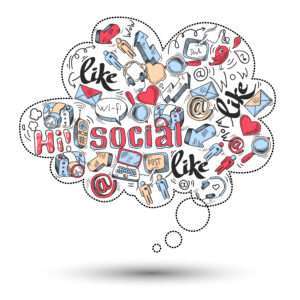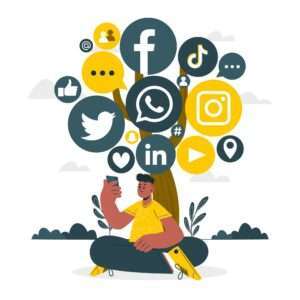 Social media has become an integral part of our daily lives, and we can see its impact everywhere, from the way we interact with each other to the products we buy. Social media has also significantly influenced the way we communicate, and as a result, our language has been shaped by it. Younger generations have adopted new slang, abbreviations, and even emojis to express themselves. But what impact does this have on society as a whole? In this post, we will explore how social media language has transformed the way we talk, write, and communicate. We will also discuss the potential effects of this language shift on future generations and how it is already changing the way we perceive the world around us. Let’s go down in and discover the power of social media language !
Social media has become an integral part of our daily lives, and we can see its impact everywhere, from the way we interact with each other to the products we buy. Social media has also significantly influenced the way we communicate, and as a result, our language has been shaped by it. Younger generations have adopted new slang, abbreviations, and even emojis to express themselves. But what impact does this have on society as a whole? In this post, we will explore how social media language has transformed the way we talk, write, and communicate. We will also discuss the potential effects of this language shift on future generations and how it is already changing the way we perceive the world around us. Let’s go down in and discover the power of social media language !
What is social media language?
Social media language is a term used to describe the unique vocabulary, syntax, and writing style that has emerged on social media platforms. This language is characterized by its informal tone, use of slang, and brevity, with many words and phrases being abbreviated or shortened. It is a language that is constantly evolving and adapting to new trends and fads and is largely influenced by the current generation’s culture and values.
In many ways, social media language has become a reflection of the current generation’s identity. And a way to express their thoughts, emotions, and opinions in a way that is authentic and relatable to their peers. It is also a language that has created a sense of community and belonging among its users, with the use of hashtags, memes, and other forms of social media. Vernacular creating a shared language and culture among individuals from different backgrounds and locations.
As social media continues to play an increasingly important role in our lives, the influence of social media language is only likely to grow, shaping the way we communicate with each other both online and offline.
The impact of social media language on the current generation
Social media has become a dominant force in the way people communicate and interact with one another. With the rise of social media platforms, the way we speak and the words we use have evolved rapidly. The impact of social media language on the current generation is significant and cannot be overstated.
The language used on social media platforms has influenced the way individuals communicate with each other. Abbreviations, acronyms, and shortened words have become commonplace, making traditional writing and communication styles seem outdated. The use of emojis has also risen in popularity, providing a visual language that can convey emotions and feelings in a effective way.
Furthermore, social media has given rise to new words and slang that were previously nonexistent. The younger generation is particularly susceptible to these new words and phrases, and they have become a crucial part of their everyday language. This has led to a generational divide in language use, with older generations struggling to understand the constantly evolving social media language.
Overall, the impact of social media language on the current generation is significant. It has given rise to new words, abbreviations, and emojis that have become a ubiquitous part of modern communication. It will be interesting to see how social media language continues to evolve and impact the way we communicate in the future.
The role of social media language in shaping cultural norms
Social media has become an integral part of our daily lives, and it has a significant impact on how we communicate with each other. The language used on social media has evolved over time, and it has played a crucial role in shaping cultural norms. The use of abbreviations and acronyms has become common, and it has influenced the way we communicate with each other. For instance, “LOL” means “laugh out loud,” and “OMG” means “oh my god.” These abbreviations have become part of our daily vocabulary, and they have influenced the way we communicate in our personal and professional lives.
The language used on social media has also influenced the way we express our emotions. Emojis have become a popular way of expressing how we feel, and they have replaced traditional methods of communication. The use of emojis is not limited to personal communication, but it has also been adopted in the business world. Companies use emojis to connect with their customers and to create a more personal relationship.
Social media language has also influenced the way we perceive ourselves and others. Social media platforms have created a culture where people are judged by the number of followers they have or the number of likes they receive. This has led to people creating a false persona or a “perfect” life on social media. The use of filters and editing tools has become common, and it has created an unrealistic standard of beauty.
In conclusion, social media language has become an essential part of our daily lives, and it has played a crucial role in shaping cultural norms. It has influenced the way we communicate with each other, express our emotions, and perceive ourselves and others. It is important to be aware of the impact of social media language and to use it responsibly.
How social media language creates a sense of community
Social media language has created a unique sense of community among its users. The use of hashtags, emojis, and acronyms has become a way of communication that is exclusive to social media platforms. It is a language that is used to connect with people who share similar interests, beliefs, or experiences. When people use hashtags, they are joining a conversation or a movement. It is a way of identifying themselves with a group, and it creates a sense of belonging.
Emojis, on the other hand, have become a universal language that transcends cultural and linguistic barriers. They can convey emotions and messages in a way that words cannot. They add a personal touch to a message and can bring people closer together. Acronyms, such as LOL (laugh out loud) or BRB (be right back), have become so widely used that they have become part of everyday language for many people. They provide a quick and efficient way of communicating, and they create a sense of familiarity and understanding among users.
Overall, social media language has created a unique sense of community that is exclusive to its users. It has become a way of identifying oneself with a group and creating a sense of belonging. The use of hashtags, emojis, and acronyms has become a universal language that connects people from different cultures and backgrounds. Social media language has changed the way we communicate and interact with each other, and it has become an integral part of modern-day communication.
The use of social media language in political discourse
Social media language has created a unique sense of community among its users. The use of hashtags, emojis, and acronyms has become a way of communication that is exclusive to social media platforms. It is a language that is used to connect with people who share similar interests, beliefs, or experiences. When people use hashtags, they are joining a conversation or a movement. It is a way of identifying themselves with a group, and it creates a sense of belonging.
Emojis, on the other hand, have become a universal language that transcends cultural and linguistic barriers. They can convey emotions and messages in a way that words cannot. They add a personal touch to a message and can bring people closer together. Acronyms, such as LOL (laugh out loud) or BRB (be right back), have become so widely used that they have become part of everyday language for many people. They provide a quick and efficient way of communicating, and they create a sense of familiarity and understanding among users.
Overall, social media language has created a unique sense of community that is exclusive to its users. It has become a way of identifying oneself with a group and creating a sense of belonging. The use of hashtags, emojis, and acronyms has become a universal language that connects people from different cultures and backgrounds. Social media language has changed the way we communicate and interact with each other, and it has become an integral part of modern-day communication.
The influence of social media language on mental health
The language we use on social media can have a significant impact on our mental health. Social media is a platform where many people express their thoughts, feelings, and opinions. However, some people use social media to express negative thoughts and engage in cyberbullying, which can have adverse effects on mental health.
The language used on social media can create an environment that promotes negative self-image, anxiety, depression, and other mental health issues. For example, the use of derogatory language, hate speech, and body-shaming can lead to low self-esteem and negative body image.
Additionally, the constant comparison to others on social media can lead to feelings of inadequacy and anxiety. The pressure to present a perfect life on social media can also cause stress and anxiety, leading to a rise in mental health problems like depression and anxiety.
On the other hand, social media can also be a powerful tool for positive mental health. Encouraging language, sharing inspirational quotes, and promoting self-love and self-care can help people feel more positive about themselves and their lives. It’s essential to recognize the power of language on social media and use it in a way that promotes positive mental health for us and others.
The challenge of preserving traditional language and communication skills
The rise of social media has brought about a new culture of communication that is heavily reliant on abbreviations, and emojis. With people now able to communicate with others from all over the world with just a few clicks, communication skills are at risk of being lost.
Many experts fear that the over-reliance on social media language could lead to a decline in traditional communication skills such as grammar, and sentence structure. This decline can be seen in the way people communicate on social media, with many users using shortened words instead of proper language.
This poses a challenge for society, as the ability to communicate effectively is essential for personal and professional success. It’s important to encourage people, especially the younger generation, to maintain their traditional language and communication skills.
One way to preserve traditional language and communication skills is through education. Schools and universities can incorporate language into their curriculums and encourage students to use proper language when communicating on social media.
Another way is by promoting the use of language and communication skills in the workplace. Employers can encourage their employees to use proper language in their communications with clients and colleagues. It provides training to improve their language and communication skills.
Overall, it’s important for society to recognize the value of traditional language and communication skills. Take steps to preserve them in the age of social media.
How to harness the power of social media language for positive change
The language used on social media has a profound impact on the current generation. It can shape opinions, beliefs, and even political views. But with great power comes great responsibility. As individuals and businesses, we should strive to harness the power of social media language for positive change.
One way to do this is to use social media as a platform to spread awareness about important social issues. For example, you could share articles, videos, or infographics about mental health, climate change, or social justice. By using inclusive and respectful language, you can help create a safe space for people to discuss and learn about these topics.
Another way to harness the power of social media language is to use it to promote positivity and kindness. By sharing uplifting stories or using positive affirmations in your posts, you can create a ripple effect of kindness and inspire others to do the same. Additionally, by avoiding negative language, you can help cultivate a more supportive and compassionate online community.
Lastly, it’s important to remember that social media language has real-world consequences. Use your words carefully, and always think before you post. By being mindful of the language you use on social media, you can help create a better and more inclusive world.
The responsibility of individuals and organizations in promoting healthy social media language use
It’s important to recognize the responsibility that individuals and organizations have in promoting healthy social media language use. The power of social media can be harnessed for good, but it can also be used to spread negativity and hate.
Individuals can take responsibility by being mindful of the language they use in their posts and comments. It’s important to remember that words have power and can impact others in ways we may not even realize. Before hitting the “post” button, take a moment to consider how the language you’re using may make others feel.
Organizations can also play a role in promoting healthy social media language use. This can be done by setting clear guidelines for employees who post on behalf of the company. As well as monitoring comments on company social media pages to ensure they are respectful and appropriate. By promoting positive language use, organizations can help create a safer and more inclusive social media environment for all.
It’s important to remember that social media language use is not just about being politically correct. It’s about promoting respect, empathy, and kindness towards others. By taking responsibility for our own language in our organizations, we can help create a more positive and impactful social media experience for everyone.
Conclusion: The future of social media language and its impact on society
In conclusion, social media language has had a profound impact on the current generation and will continue to shape our society in the future. As social media platforms continue to evolve, so will the language used on them, and it’s important for us to keep up with these changes.
While social media language has its benefits, such as breaking down language barriers and creating a sense of community. It also has its drawbacks, such as promoting negativity and damaging mental health.
It’s up to us as individuals to use social media language responsibly and to promote positive communication. Social media platforms also have a responsibility to monitor and regulate the language used on their platforms and to create a safe and inclusive environment for all users.
As we move forward, it’s important to recognize the power of social media language and its potential impact on our society. By staying informed and aware of the language used on these platforms, we can create a more positive and productive online community.
We hope you enjoyed the blog post of languages unlimited about how social media language shapes the current generation. Social media has become an integral part of our lives, and it’s clear that the way we communicate online is different from how we communicate in person. Understanding the language and trends of social media is crucial for businesses to connect with their customers and target audience. It’s fascinating to see how social media language has evolved, and we are excited to see what the future will bring.


